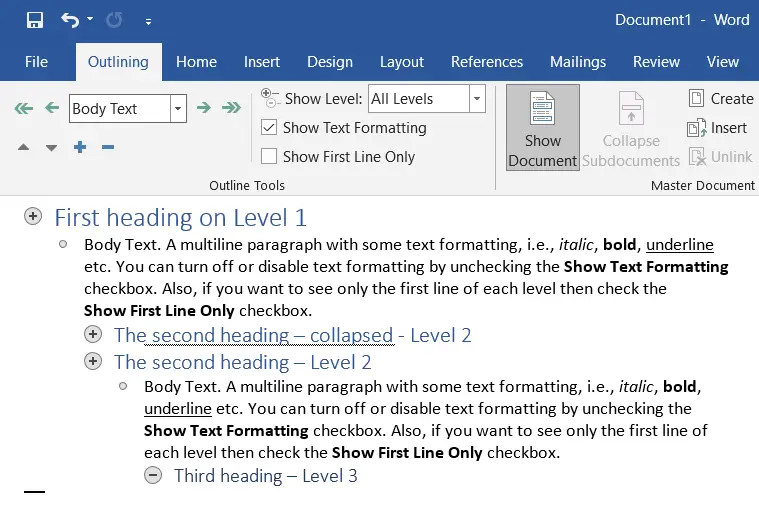For organizing and managing a document, Outline view provides powerful tools that enable you to move whole sections of the document around without having to copy, cut, and paste. When you use “Heading 1” through “Heading 9” styles in a document, you can use Outline view to organize and reorganize your text. The highest level in the outline is Heading 1 level and the lowest level is Body Text level. To switch to Outline view, click the View tab and click the Outline button.
When you display your document in Outline view, the Outlining tab appears automatically in the Ribbon. The Outlining tab provides two different groups: Outline Tools and Master Document. In this tutorial we’ll discuss the Outline Tools group:

 Promote to Heading 1
Promote to Heading 1
Promote this item to the highest outline level Promote
Promote
Promote the outline level of this item by one level Outline Level
Outline Level
View and choose the outline level for the selected item. Demote
Demote
Demote the outline level of this item to lower level by one level Demote to the Body text
Demote to the Body text
Demote this item to the lowest outline level (Body text) Move Up
Move Up
Move the item up within the outline Move Down
Move Down
Move the item down with in the outline Expand
Expand
Expand the selected item to show subheadings and text Collapse
Collapse
Collapse the selected item by hiding subordinate headings and text Show Level
Show Level
Use this list to decide which outline levels must be shown. Each level selected shows the level selected and all precedent levels. For example, by selecting Level 1, just Heading1 paragraph styles are shown. Selecting Level 2, Heading1, and Heading2 paragraphs are shown. Show Text Formatting
Show Text Formatting
Checked by default. Uncheck to turn off the display of formatting. All your text will now appear in your default font without any formatting. Show First Line Only
Show First Line Only
Unchecked by default, shows just the first body text line inside each item.
Creating a new Outline
Creating a new outline in Word is simple, click the Outline button in the View tab. When you start a document in Outline view, the first line you type automatically becomes the “Heading 1”. You can press the Tab keyboard button to demote a line to the next heading level (for example: Heading 1 to Heading 2, or Heading 2 to Heading 3). To promote a line to the next higher heading level press Shift+Tab keyboard buttons. Follow these steps to start the new outline:
- Start typing the text, the first line automatically formatted in the Heading 1 style. Press enter to move to the next line.
- To create a sublevel, click
 Demote on the Outlining toolbar or press Tab. Type the text for that entry and press Enter to move to the next line.
Demote on the Outlining toolbar or press Tab. Type the text for that entry and press Enter to move to the next line. - By default, Word formatted the next line at the same level as the level you last selected. You can choose a different level by clicking the
 Demote or
Demote or  Promote on the Outlining toolbar.
Promote on the Outlining toolbar. - Continue typing entries until your outline is completed.
When you start writing the document in outline view, several different types of symbols appear. These symbols let you know what action to take while you are working in the outline view:
 This symbol indicates that this item contains subheadings or text paragraphs. Double-click this symbol to collapse or expand a topic and all its subtopics.
This symbol indicates that this item contains subheadings or text paragraphs. Double-click this symbol to collapse or expand a topic and all its subtopics. This symbol indicates that there are no subordinate headings or text paragraphs
This symbol indicates that there are no subordinate headings or text paragraphs This symbol indicates that the lowest-level outline entry is formatted as Body Text.
This symbol indicates that the lowest-level outline entry is formatted as Body Text.
The wavy underlining indicates that there are subheadings or paragraphs collapsed under the heading. Treat it as a visual aid to help you avoid deleting precious pages when you intend to delete only a heading.:
When you open an existing document in Outline view, the document window changes, everything expanded and handles (symbols) appear to the left of each level to organize the levels.
Move content without needing to select, copy, and paste
Using the Outline view, you can move large blocks of text to a new position without needing to select, copy, and paste text in the document; instead, you can use the:
 Move down or
Move down or  Move up tools
Move up tools
For a single item just use the Move up and Move down tools. But if the item (heading) has subheadings and paragraphs, first collapse it in and then use the Move up or Move down tools or just drag the collapsed item with the mouse to a new position. All text will be repositioned inside the document.
Outline View Keyboard Shortcuts
Expand and Collapse Outline View
You can use keyboard shortcuts to quickly expand or collapse the outline:
Alt+Shift+1throughAlt+Shift+9
Collapse or expand to the specified heading level (1 through 9).Alt+Shift++
Expand the selected item by one heading level.Alt+Shift+-
Collapse the selected item by one heading level.Alt+Shift+A
Toggle the display of all heading levels.
Keyboard Shortcuts to Promote or Demote Outline View
You can also use the keyboard shortcut to demote or promote a topic, or to move up or down one line:
Alt+Shift+→(right arrow key)
Demotes a topicAlt+Shift+←(left arrow key)
Promotes a topicAlt+Shift+↑(up arrow key)
Moves a topic up one lineAlt+Shift+↓(down arrow key)
Moves a topic down one line

